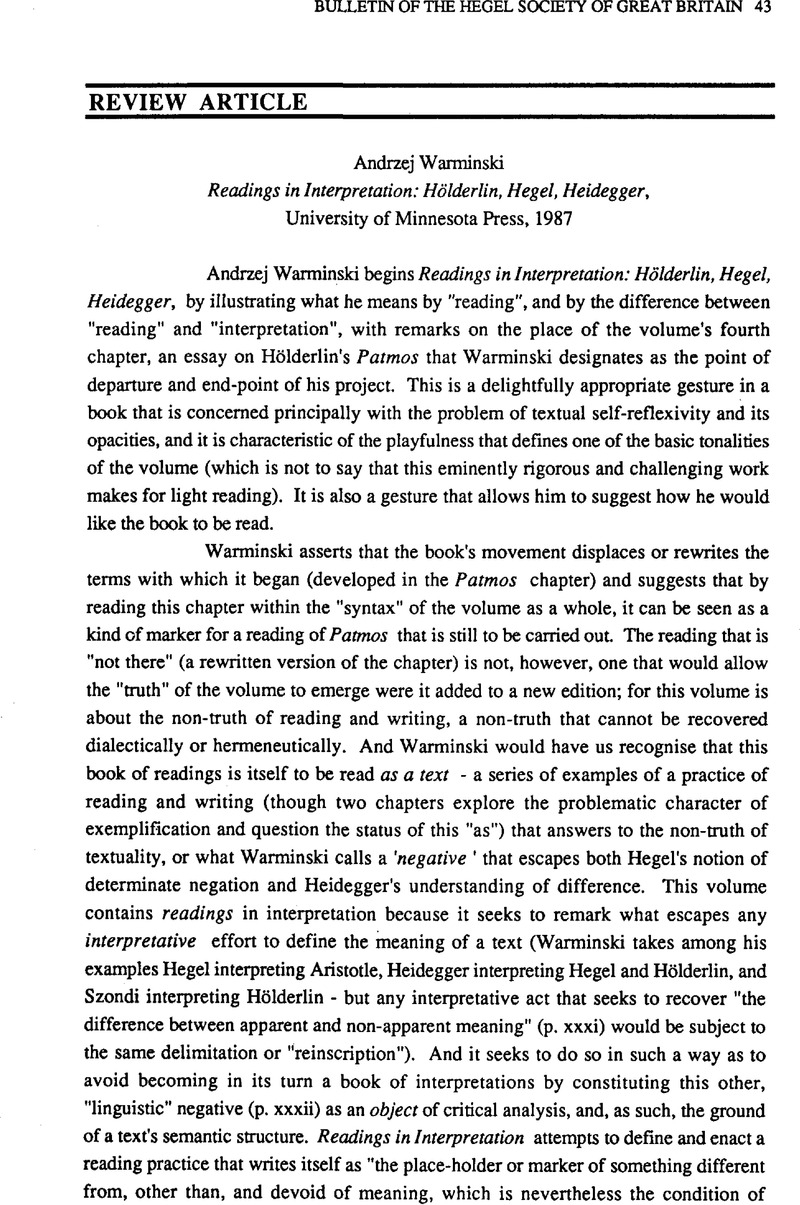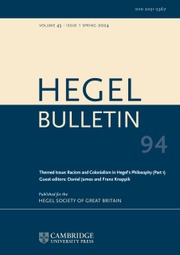No CrossRef data available.
Article contents
Andrzej Warminski, Readings in Interpretation: Hölderlin, Hegel, Heidegger, University of Minnesota Press, 1987
Review products
Published online by Cambridge University Press: 23 June 2015
Abstract

- Type
- Review Article
- Information
- Bulletin of the Hegel Society of Great Britain , Volume 9 , Issue 2: number 18 , Spring/Summer 1988 , pp. 43 - 57
- Copyright
- Copyright © The Hegel Society of Great Britain 1988
References
1 Warminski provides a schematic description of his practice of reading in the same “Prefatory Postscript” in which he discusses his “Patmos” chapter. He mimes here Derrida's presentation of his own deconstructive strategy in Positions by describing his practice in three steps, and cites in this manner the second authority of his text. Warminski is concerned with defining in this book a very strict notion of deconstruction and moves with remarkable dexterity between the texts of de Man and Derrida to do so. However, the unsympathetic treatment he reserves for Philippe Lacoue-Labarthe and Sarah Kofman (two French philosophers who have worked closely with Derrida) is a sign that Warminski is closer in approach and attitude - what I might call his critical posture - to de Man than to Derrida. This point is corroborated by Warminski's tendency to restrict his range of questions to matters involving the written text (though he is fully cognizant of the range Derrida gives to the term “text”) and his shyness regarding questions of an ontological or existential character (which lead even in Heidegger's text into the question of writing and thus remain viable in a Derridean framework). But Warminski's training in philosophy and his extremely sure reading of Derrida give his theoretical approach rare depth in the context of American deconstruction and allow him to handle texts in a distinctive way. I would argue, for example, that his readings of Heidegger (and consequently, one might say, of Hölderlin) are significantly stronger than any de Man had time to publish. Warminski is also sensitive to Blanchot's understanding of literary language in a way that gives his reading a distinctive cast.
2 Although the notion of textuality that Warminski is approaching in the wake of Derrida's and Blanchot's meditation on language radically unsettles Heidegger's understanding of the “gathering” nature of the essence of language. I have developed the point I am making here about the fact of language in a paper I delivered to the Collegium Phaenomenologicum in Perugia, August, 1987, entitled “Qu'il y ale langage…: Heidegger, Derrida”. I might add that Warminski stresses the point that this “fact of language” makes language an “open tropological system that can be ‘what it is’ only by not being a system, by not being anything that could be ‘what it is’ in the terms of any ontology” (p. 1). I agree entirely with this statement if we emphasise the “what” (for I believe one can say that it is) and if we take “ontology” in a strict sense; but it should not be forgotten that with the notion of textuality we are dealing with a “quasi-transcendental” (as Rodolphe Gasché would put it) and the point of articulation between the question of Being and the question of writing.
3 See Derrida's, essay by this name in Psyché (Paris, Galilée, 1987), pp. 63–94 Google Scholar. A translation of the essay appears in Enclitic, Vol. 2, No. 2, Fall 1978, pp. 4–33 Google Scholar.
4 Let me add that it would important to explore the relation (which would be possible only in a logic of finitude) between the opening to “Silenic wisdom” and the opening of the possibility of signification which together constitute the wounding that is the Dionysian experience. If we collapse these dimensions of the experience as Warminski appears to do when he substitutes the “nothing” of representation for the Silenic wisdom (though perhaps not without a remainder which may well be appearing when Warminski says of the wounding that it is “not so much [my emphasis] by Dionysus … as by … [p. 11]) we risk turning the opening of the possibility of signification into a final term as opposed to a limit (which as a limit would mark a relation to an alterity). There is no hors-texte, as Derrida has said, but this is only to say that there is no hors-texte. The text (taken in the most extended Derridean sense) must be taken as a limit with a fundamentally temporal character (once again, it must be thought in its finitude). It must be thought as a boundary and as a threshold that marks itself as such (though this is not the as such of philosophy: there is [es gibt] the text, we can say) - a threshold that is never crossed, but that we are always (in the process of) crossing. The opening of language in its possibility occurs with (and from out of) the experience of the Nothing, Heidegger says in “What is Metaphysics?”; it thus necessarily occurs with an experience of what Bataille named (in a way that is perhaps consonant with Heidegger's use of the term, but certainly closer to Nietzsche's understanding of the Dionysian) the earth. A term like “earth” demands careful analysis, but it points to dimensions of experience that should not be foreclosed by an exclusive focus on language.
5 I refer the reader to Warminski's footnote 18 from this chapter. Warminski asks us to read in its entirety the sentence in which Nietzsche sneaks of the justification of existence as an aesthetic phenomenon, arguing that “aesthetic” is “not to be understood in terms of idealist subject-object conceptions of art and aesthetics” (p. lii). But if we read the following two sentences of this section, we see the persistence of the categories of speculative idealism (“… for in this state he [the genius] is … like the wierd image of the fairy tale which can turn its eyes at will and behold itself; he is at once subject and object, at once poet, actor, and spectator” [Kaufmann's translation]). Even more disturbing in Nietzsche's text is the role played by an essentially romantic notion of myth in the latter sections.
6 Rodolphe Gasché focuses on the figure of the chiasmus in his excellent introduction to the volume.
7 One might ask, for example, how an Egyptian who speaks “allegorically” could represent Hölderlin's “oriental principle” of “holy pathos” and thus be fundamentally related to the Greek “nature”. And correspondingly, one would have to ask how Empedocles, who is certainly characterised by “holy pathos”, could be identified with a “Junonian sobriety”. (And yet Empedocles must be in this position if the confrontation Warminski is schematising is to work properly.) I suspect that the inscription of the Egyptian in HOlderlin's categories must be carried out somewhat differently (with more emphasis on the meaning of “Junonian sobriety” and “clarity of representation”), though I would not contest Warminski's basic point that whatever Manes represents must be considered in Hölderlin's poetical-historical schemas.
8 A translation of Lacoue-Labarthe's, La Césure du séiculatif, collected in L'imitation des moderns (Paris: Galilée, 1986)Google Scholar, appears in a volume of essays by Lacoue-Labarthe that I have edited for the Harvard University Press: Typography: Mimesis, Philosophy, Politics (1989). Warminski fails to recognise in his critique the extensive reformulation to which Lacoue-Labarthe submits the category of mimesis (throughout his work). Lacoue-Labarthe is in fact describing something very much like Warminski's “linguistic negative”.
9 Warminski's claim that he might multiply such readings remains only implicit in this chapter, but it would seem that one would not have trouble showing similar undeterminable textual processes at work Ihoughout Hegel's work (as in the case of the beginnings of Hegel's Logic).
10 Or he would assert that it is dialectisable only up to a certain point. Just as he would recognise an irreducible “ontic” determination in the “we” of his text, he would recognise that the “turn” of his thought is, up to a certain limit, accounted for by Hegel's text.
11 Indeed, one might say that most readers of Heidegger read his text as philosophy by failing to note what happens in the text when it begins to move beyond the horizon of signification. The invisibility of the written character of Heidegger's text for most readers is a demonstration of Warminski's point.
12 Blanchot, Marice, “Literature and the Right to Death”, in The Gaze of Orpheus, trans. Davis, Lydia (Barrytown: Station Hill Press, 1981), p. 25 Google Scholar.




